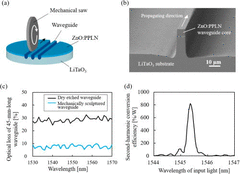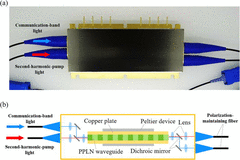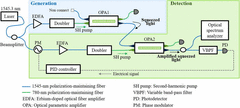


NTT:实现机架尺寸的大型光子计算机:
-光纤耦合量子光源核心技术研发成功-
发展概况:
光源模块的实现:
实现“机架式、大型光子计算机”
开发出核心器件“光纤连接型高性能挤压光源模块”。
用于光通信的光学元件:
我们使用了“光纤耦合量子光源模块”和“光通信用光学元件”。
超过 6 太赫兹或更高的宽带
量子噪声压缩75%以上,
用于产生连续波挤压光
我们在世界上第一次在光纤光学系统方面取得了成功。
对光子计算机发展的贡献:
这个结果是
开发“稳定、免维护的光通信设备封闭系统”。
我们使开发具有真实设备规模的光子计算机成为可能。
未来,实用机器的开发将取得长足的进步。
量子计算机:
叠加态和量子纠缠态
利用量子力学特有的现象,
超并行计算处理成为可能。
光子计算机的优势:
世界各地都在进行研究和开发。
目前,已经设计了各种方法。
其中,
“用光子计算的光学量子计算机,这是光的量子”有很多优点。
实际小型化是可能的:
例如,
由于不需要其他方法所需的冷冻和真空设备,
实用的小型化是可能的。
无限增加量子比特数:
你可以“创造一个连续的纠缠状态”。
您可以“在不集成或并行化设备的情况下几乎无限地增加量子比特的数量”。
利用光宽带的高速计算:
还可以利用宽频带的高速计算处理。
当然,量子纠错也是可能的。
而且,
而不是用单个光子表示一个量子位
一种用大量光子表示量子位的技术,
理论上也表明“使用光子数的均匀性进行量子误差校正是可能的”。
与光通信技术的亲和力:
这种方法与光通信技术有很高的亲和力。
通信波段低损耗光纤,
在光通信中使用高性能光器件,
我们可以期待在实际机器的建造方面取得巨大的发展。
https://www.jst.go.jp/pr/announce/20211222-2/index.html
光子计算机研究支持基金 | 东京大学基金
光量子コンピューター研究支援基金 | 東京大学基金
https://utf.u-tokyo.ac.jp/project/pjt93?reportId=pjReportDetail1
Fabrication of low-loss quasi-single-mode PPLN waveguide and its application to a modularized broadband high-level squeezer:
Applied Physics Letters: Vol 119, No 25
ABSTRACT
A continuous-wave (CW) broadband high-level optical quadrature squeezer
is essential for high-speed large-scale fault-tolerant quantum computing on a time-domain-multiplexed continuous-variable optical cluster state.
CW THz-bandwidth squeezed light
can be obtained with a waveguide optical parametric amplifier (OPA);
however,
the squeezing level has been insufficient for applications of fault-tolerant quantum computationbecause of degradation of the squeezing level due to their optical losses caused by the structural perturbation and pump-induced phenomena.
Here,
by using mechanical polishing processes, we fabricateda low-loss quasi-single-mode periodically poled LiNbO3 (PPLN) waveguide,
which shows 7% optical propagation loss with a waveguide length of 45 mm.
Using the waveguide,
we assembled a low-loss fiber-pigtailed OPA modulewith a total insertion loss of 21%. Thanks to its directly bonded core on a LiTaO3 substrate,
the waveguide does not show pump-induced optical loss even under a condition of hundreds of milliwatts pumping.Furthermore,
the quasi-single-mode structure prohibits excitation of higher-order spatial modes and enables us to obtain larger squeezing level.Even with including optical coupling loss of the modularization,
we observe 6.3-dB squeezed light from the DC component up to a 6.0-THz sideband in a fully fiber-closed optical system.
By excluding the losses due to imperfections of the modularization and detection,
the squeezing level at the output of the PPLN waveguide is estimated to be over 10 dB.
Our waveguide squeezer
is a promising quantum light source for high-speed large-scale fault-tolerant quantum computing.